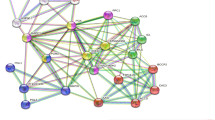Abstract
A great number of microRNAs (miRNAs) have been identified in responding and acting in gene regulatory networks associated with plant tolerance to abiotic stress conditions, such as drought, salinity, and high temperature. The topological exploration of target genes regulated by abiotic-stress-responsible miRNAs (ASRmiRs) in a network facilitates to discover the molecular basis of plant abiotic stress response. This study was based on the staple food rice (Oryza sativa) in which ASRmiRs were manually curated. After having compared the topological properties of target genes (stress-miR-targets) with those (non-stress-miR-targets) not regulated by ASRmiRs in a rice interactome network, we found that stress-miR-targets exhibited distinguishable topological properties. The interaction probability analysis and k-core decomposition showed that stress-miR-targets preferentially interacted with non-stress-miR-targets and located at the peripheral positions in the network. Our results indicated an obvious topological distinction between the two types of genes, reflecting the specific mechanisms of action of stress-miR-targets in rice abiotic stress response. Also, the results may provide valuable clues to elucidate molecular mechanisms of crop response to abiotic stress.




Similar content being viewed by others
References
Akpinar BA, Kantar M, Budak H (2015) Root precursors of microRNAs in wild emmer and modern wheats show major differences in response to drought stress. Funct Integr Genomics 15(5):587–598
Aranda B et al (2010) The IntAct molecular interaction database in 2010. Nucleic Acids Res 38(suppl 1):D525–D531
Assenov Y et al (2008) Computing topological parameters of biological networks. Bioinformatics 24(2):282–284
Bader GD, Hogue CW (2003) An automated method for finding molecular complexes in large protein interaction networks. BMC Bioinforma 4(1):2
Barabasi A-L, Oltvai ZN (2004) Network biology: understanding the cell’s functional organization. Nat Rev Genet 5(2):101–113
Bartel DP (2004) MicroRNAs: genomics, biogenesis, mechanism, and function. Cell 116(2):281–297
Bartel PL, Fields S (1997) The yeast two-hybrid system. Oxford University Press
Brandao MM, Dantas LL, Silva-Filho MC (2009) AtPIN: Arabidopsis thaliana protein interaction network. BMC Bioinforma 10:454
Brown KR, Jurisica I (2005) Online predicted human interaction database. Bioinformatics 21(9):2076–2082
Bu D et al (2003) Topological structure analysis of the protein–protein interaction network in budding yeast. Nucleic Acids Res 31(9):2443–2450
Budak H et al (2015a) Stress responsive miRNAs and isomiRs in cereals. Plant Sci 235:1–13
Budak H, Khan Z, Kantar M (2015b) History and current status of wheat miRNAs using next-generation sequencing and their roles in development and stress. Brief Funct Genomics 14(3):189–198
Burnham JF (2006) Scopus database: a review. Biomed Digit Libr 3(1):1
Cabello JV, Lodeyro AF, Zurbriggen MD (2014) Novel perspectives for the engineering of abiotic stress tolerance in plants. Curr Opin Biotechnol 26:62–70
Chatr-Aryamontri A et al (2007) MINT: the Molecular INTeraction database. Nucleic Acids Res 35(suppl 1):D572–D574
Cheng Y, Perocchi F (2015) ProtPhylo: identification of protein–phenotype and protein–protein functional associations via phylogenetic profiling. Nucleic Acids Res:gkv455
Dai X, Zhao PX (2011) psRNATarget: a plant small RNA target analysis server. Nucleic Acids Res 39(suppl 2):W155–W159
De Bodt S et al (2009) Predicting protein-protein interactions in Arabidopsis thaliana through integration of orthology, gene ontology and co-expression. BMC Genomics 10(1):288
Ge Y et al (2010) Global transcriptome profiling of wild soybean (Glycine soja) roots under NaHCO3 treatment. BMC Plant Biol 10(1):153
Giot L et al (2003) A protein interaction map of Drosophila melanogaster. Science 302(5651):1727–1736
Griffiths-Jones S et al (2006) miRBase: microRNA sequences, targets and gene nomenclature. Nucleic Acids Res 34(Database issue):D140–D144
Henderson J (2005) Google scholar: a source for clinicians? Can Med Assoc J 172(12):1549–1550
Jeong H et al (2001) Lethality and centrality in protein networks. Nature 411(6833):41–42
Kantar M, Unver T, Budak H (2010) Regulation of barley miRNAs upon dehydration stress correlated with target gene expression. Funct Integr Genomics 10(4):493–507
Kawahara Y et al (2013) Improvement of the Oryza sativa Nipponbare reference genome using next generation sequence and optical map data. Rice 6(1):4
Kuchaiev O et al (2010) Topological network alignment uncovers biological function and phylogeny. J R Soc Interface 7(50):1341–1354
Mallory AC, Vaucheret H (2006) Functions of microRNAs and related small RNAs in plants. Nat Genet 38:S31–S36
Matthews LR et al (2001) Identification of potential interaction networks using sequence-based searches for conserved protein-protein interactions or “interologs”. Genome Res 11(12):2120–2126
Morsy M et al (2008) Charting plant interactomes: possibilities and challenges. Trends Plant Sci 13(4):183–191
Pawson T (2004) Specificity in signal transduction: from phosphotyrosine-SH2 domain interactions to complex cellular systems. Cell 116(2):191–203
Pazos F et al (1997) Correlated mutations contain information about protein-protein interaction. J Mol Biol 271(4):511–523
Ren Y et al (2012) Identification of novel and conserved Populus tomentosa microRNA as components of a response to water stress. Funct Integr Genomics 12(2):327–339
Rogers K, Chen X (2013) Biogenesis, turnover, and mode of action of plant microRNAs. Plant Cell 25(7):2383–2399
Salwinski L et al (2004) The database of interacting proteins: 2004 update. Nucleic Acids Res 32(suppl 1):D449–D451
Sánchez B, Rasmussen A, Porter JR (2014) Temperatures and the growth and development of maize and rice: a review. Glob Chang Biol 20(2):408–417
Shah NR, Chen H (2014) MicroRNAs in pathogenesis of breast cancer: implications in diagnosis and treatment. World J Clin Oncol 5(2):48–60
Shen J et al (2007) Predicting protein–protein interactions based only on sequences information. Proc Natl Acad Sci 104(11):4337–4341
Smoot ME et al (2011) Cytoscape 2.8: new features for data integration and network visualization. Bioinformatics 27(3):431–432
Stark C et al (2006) BioGRID: a general repository for interaction datasets. Nucleic Acids Res 34(suppl 1):D535–D539
Sunkar R (2015) Role of microRNAs in plant abiotic stress responses. In: Plant and Animal Genome XXIII Conference. Plant and Animal Genome
Sunkar R, Li Y-F, Jagadeeswaran G (2012) Functions of microRNAs in plant stress responses. Trends Plant Sci 17(4):196–203
Uetz P et al (2000) A comprehensive analysis of protein–protein interactions in Saccharomyces cerevisiae. Nature 403(6770):623–627
Urano K et al (2010) ‘Omics’ analyses of regulatory networks in plant abiotic stress responses. Curr Opin Plant Biol 13(2):132–138
Wang P et al (2013) The MPK6-ERF6-ROS-responsive cis-acting Element7/GCC box complex modulates oxidative gene transcription and the oxidative response in Arabidopsis. Plant Physiol 161(3):1392–1408
Wheeler DL et al (2007) Database resources of the national center for biotechnology information. Nucleic Acids Res 35(suppl 1):D5–D12
Wong KA, O’Bryan JP (2011) Bimolecular fluorescence complementation. J Vis Exp (50)
Wuchty S, Almaas E (2005) Peeling the yeast protein network. Proteomics 5(2):444–449
Xie M, Zhang S, Yu B (2015) microRNA biogenesis, degradation and activity in plants. Cell Mol Life Sci 72(1):87–99
Yin F et al (2014) Genome-wide analysis of Water-stress-responsive microRNA expression profile in tobacco roots. Funct Integr Genomics 14(2):319–332
Yu H et al (2007) The importance of bottlenecks in protein networks: correlation with gene essentiality and expression dynamics. PLoS Comput Biol 3(4):e59
Zhang S et al (2013) PASmiR: a literature-curated database for miRNA molecular regulation in plant response to abiotic stress. BMC Plant Biol 13:33
Zhong W, Sternberg PW (2006) Genome-wide prediction of C. elegans genetic interactions. Science 311(5766):1481–1484
Acknowledgments
The research was supported by the National Natural Science Foundation of China (grant no. 31301248) and the Science Research Foundation of Anhui Provincial Colleges (grant no. KJ2013Z075).
Author information
Authors and Affiliations
Corresponding author
Ethics declarations
Conflict of interest
The authors declare that they have no conflict of interest.
Additional information
Linzhong Zhang and Hongdong Xuan contributed equally to this work.
Electronic supplementary material
Below is the link to the electronic supplementary material.
Supplementary File 1
(XLS 1640 kb)
Supplementary File 2
(XLS 2798 kb)
Supplementary Fig. 1
(GIF 230 kb)
Rights and permissions
About this article
Cite this article
Zhang, L., Xuan, H., Zuo, Y. et al. Topological characteristics of target genes regulated by abiotic-stress-responsible miRNAs in a rice interactome network. Funct Integr Genomics 16, 243–251 (2016). https://doi.org/10.1007/s10142-016-0481-4
Received:
Revised:
Accepted:
Published:
Issue Date:
DOI: https://doi.org/10.1007/s10142-016-0481-4




